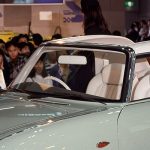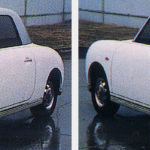Yoshiro Kobata – Pike Series Designer Interview December 2022
 As a CHRISTMAS SPECIAL, we wanted to share this amazing insight into how the Figaro was designed and where they took their inspiration from!
As a CHRISTMAS SPECIAL, we wanted to share this amazing insight into how the Figaro was designed and where they took their inspiration from!
Figaro Smiles (Facebook) founder Adam Woods got in touch with us about this very special and revealing interview with Yoshiro Kobata, Designer of Pike Cars Be-1, Pao and Figaro
Adam followed him on Instagram, and when he followed him back, Adam sent him a message thanking him for his wonderful designs. He replied by saying how happy he is that the cars have gained so many fans abroad, and are so loved! So, Adam thought to ask him if he would do an interview for the group. He replied saying that he is unable to do anything over the video, but that if I sent him some questions, he would happily reply.
So, we are delighted to share the interview with you all here on the Figaro Owners Group Page!
WATCH VIDEO
THIS INTERVIEW IN FULL
Q1 – Please can we start by asking what inspired your perspective on life, society, and the world, before you became involved in the Pike car project?
I have loved drawing and making things since I was a child. I was impressed by the architecture, street furniture and Italian cars at the 1970 Osaka Expo. I studied industrial design at Kanazawa College of Art. My dream was to have more people use the things I designed. I thought that automobiles, alongside architecture, would change the urban landscape. So, I started working for Nissan Motor Co. I am not really interested in classic cars. And I am not interested in driving fast and powerful.
“I wanted to create something that would be loved by many people and would remain in their hearts for a long time”.
Q2 – How did you become involved in the Pike car project? Was it a “meeting of minds” or were you inspired by a particular cause or purpose, that made it something you didn’t want to miss?
Around 1980, Nissan was struggling with sales. The executive in charge of development asked the leader of the design department if they could do something different and decided to look at their own unique development. They thought that “if we change the design process, the results should also change” So, we explored several methods for our own unique development in the design department …
These were the methods we tried:
- Plan A – use conventional development processes
- Plan B1 – a collaboration with external creative
- Plan B2 – as B1 but as an alternative method
- Plan C – outsource to European designers
Plan A and B2 were handled by experienced designers.
I was put in charge of Plan B because of my boss’s decision that it had “unknown potential”.
Plan B1 later became “Be-1”. (Plan B / Bi-an or B1 / Bi-One in Japanese)
Q3 – Some vehicle design has been a direct response to society’s changing needs. What was the development of the Be-1, and the following Pike cars, responding to in Japan of the 1980s?
In the late 1980s and 1990s, Japan was in a bubble economy. Most cars were high-powered and high-tech. People were beginning to get tired of such competition. The situation was very similar in other countries. We tried to go back to our roots. We thought that such a lifestyle would be acceptable to those who preferred cutting-edge living. Although the number of such particular people was small, we thought the influence would gradually expand – postmodernism and semiotics were becoming popular in Japan at the time.
Q4 – With the advent of video games like Pokemon on the Game Boy in the late 1980s, do you feel that the creation of cute beings in an anime style was enabled by the same design concepts behind the Be-1 and the following Pike cars as more of a cute and friendly frame of reference for Japanese society?
The similarities with the game characters are coincidental. As an aside, Mr. Miyamoto of Nintendo, famous for Super Mario Bros, was a classmate of mine at university. We did not set out to create something cute. It is the result of expressing naturalness, comfort and gentleness.
Q5 – Huge congratulations to you, as last year the Be-1 was recognised as a Heritage Car by the Japanese Automotive Hall of Fame. What lasting legacy do you feel that the Be-1 and the other concept variations have given to Japanese society?
The Be-1 was recognised for its influence on cars around the world, as it was the catalyst for roundness in automobile design, which had previously been angular. It is credited with influencing the new Beetle, the new Mini, the PT Cruiser and the Fiat 500. This is the first reason for the design to be recognised. In Japan, many Be-1-like designs were also used in kei cars (K-cars). I consider design to be performance.
Q6 – While the Be-1 was the original concept, the Pao and Figaro were an evolution of the design. Do you feel they responded to a particular requirement? Or did, for example, the Figaro as a 2 seater coupe, not really match with what you wanted the Pike Cars Project to achieve?
PAO and FIGARO are variations on a concept and design. They help to expand the fan base of Pike cars, but they do not create new values like the Be-1. The Be-1 was produced in a limited edition, and its popularity was unexpected. Therefore, PAO went for a three-month order period and a strategy of selling to everyone who wanted one. It also took on the challenge of following in the Be-1’s footsteps, but with a different style.
“Many teams competed and struggled with the FIGARO development. The idea was then to create a coupe based on the unusual nature of the PAO. It wasn’t competing with sporty cars or small luxury cars – the turbocharged engine compensates for the weight overload caused by the hood and seats, not to make the car go faster”.
Showing radical decorative design beforehand was also an important strategy. So, I proposed a different idea for the decorative part of the car.
Q7 – Were there concepts and ideas you considered that wasn’t realised in the final production vehicles? Were there any concepts you wished you had pursued further, or wish you hadn’t?
We had a lot of ideas, including from other teams – for a two-seater like a motorbike or a wagon. However, it has not been made public. With the Be-1 and PAO, there were few competing ideas. The PAO style, in particular, could only be realised by me. Another idea for FIGARO that I tried was a three-box sedan based on the Sunny. The concept was a romantic sedan, with an art deco decorative design. Unfortunately, this other concept cannot be shared with the public. But without this idea, the ivy-like mouldings and bud-like details of the FIGARO would never have been created.
Q8 – The Pike cars were designed for the Japanese market. Over here in the UK, they inspire a lot of positivity – smiles and goodwill. Do you feel the cars being exported to other places has had a positive impact on those other markets? What can Western society learn from your designs?
They are privately exported vehicles scrapped in Japan by used car dealers and repair shops with good business acumen. The Pike Car is a design that is easily accepted in Europe. There is a culture of valuing old cars, which is better than scrapping them in Japan. I am happy that the cars I designed are not scrapped and spend the rest of their lives in Europe, the US and South East Asia. Japanese, European and US car manufacturers use 3D and high-tech design and production techniques. But I think we need more development using human hands. I believe that Pike cars have traces of hands in every corner. You will feel the traces of human handwork when you wash your Pike car.
Q9 – How does it feel for you that these cars have such a dedicated following today? 30 years ago, would you have expected today’s owners to be so committed to keeping these cars on the road?
Our development team expected the Pike cars would be in use for a long time.
“That’s why we used the most advanced technology of the time. We used a luxurious Canadian rust-proof steel sheet, careful rust-proofing treatment, a resin exterior that was baked with the exterior panel and applied a fluorine coating, only used on luxury cars. As a designer, I am proud of the team at the production site”.
FIGARO was also carefully made. However, after 30 years it deteriorates, and it becomes difficult to supply parts. FIGARO in particular has a lot of electronic parts, which may be difficult to maintain, but I’m sure that everyone in the UK who takes care of old cars will be fine. Please continue to take good care of them and enjoy them.
Q10 – The Pike cars were a response to the needs of Japanese society. What do you feel that society needs now? What’s next?
What society needs now is long-life EVs, but no EV will probably be able to be driven with love for 30 years. Instead of throwing cars away, we need long-life cars with less environmental impact. There are already come converted Pike EVs, but I hope that the time will come when EVs will be built with designs like the Be-1, PAO and FIGARO. A concept can only be expressed in a form. Design can be made visible. Design evolution may succeed by chance. It is Be-1 that pushed my design capabilities. The Pike Car Project is not viable in today’s demanding society. It is a legend from a more relaxed past.
We are incredibly grateful to Yoshiro Kobata for providing his responses and insights and allowing us to use his images. But, of course, beyond all else, THANK YOU for creating such wonderful cars!
Image licencing
Yoshiro Kobata granted permission to publish the images contained within this article.
Further Reading
Website Click Here
Blog Click Here
For other links Click here and Click Here















